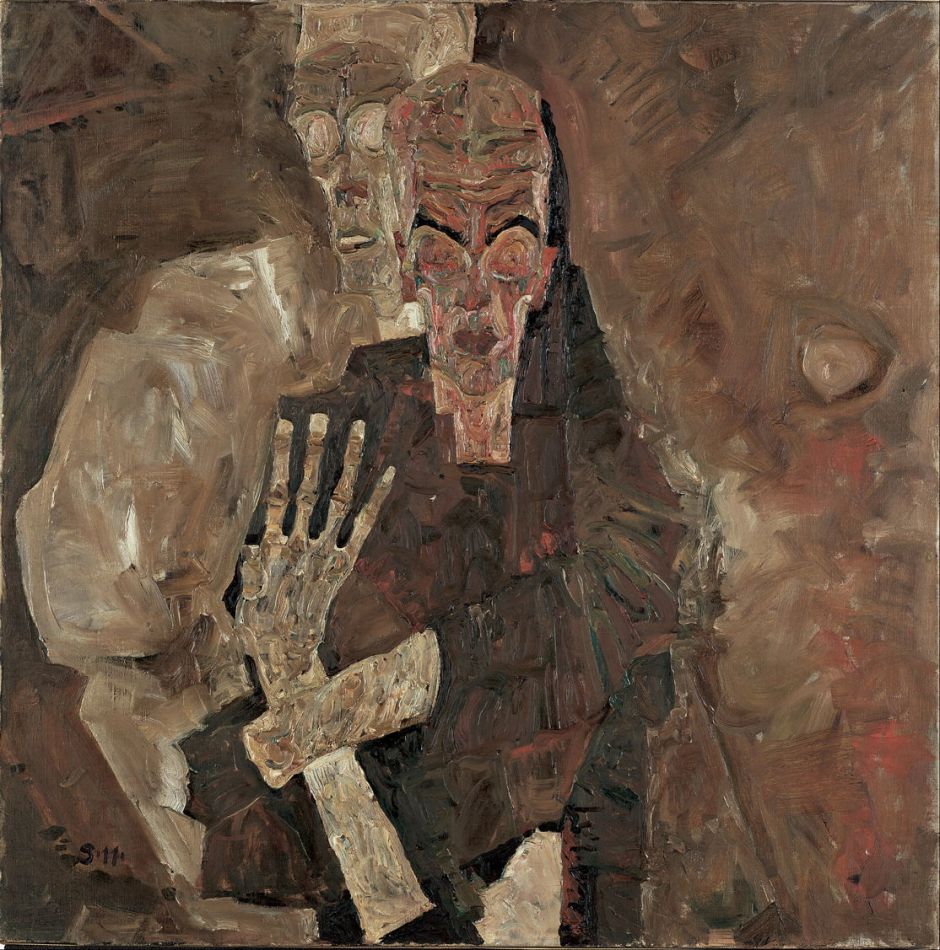The last of my group of great central European artists who died a century ago this year is Egon Schiele (1890–1918), a protégé of Gustav Klimt who was greatly influenced by him, and in his brief life carved a new course in twentieth century art.
There’s a lot of Schiele’s art which I don’t particularly like, and some which I find deeply disturbing. However, he is an important artist, started a very promising career which was tragically cut short, and was so prolific that I hope I can steer a course through his work which is neither unrepresentative nor offensive. I will therefore look broadly across his output, focussing particularly on his landscapes, which I find most interesting.
Egon Leo Adolph Schiele was born on 12 June 1890 in the small town of Tulln an der Donau in Lower Austria. His father worked for the railway company, and the family lived in a flat in the town railway station. Egon Schiele was an early and enthusiast draftsman, but didn’t progress well in his other school subjects. His father had contracted syphilis before marriage; during Egon’s childhood his father’s health was breaking down, and he died of progressive paralysis when Egon was only fourteen.
With the family in difficult financial circumstances, a prosperous uncle was made Schiele’s guardian. He was as unimpressed by Egon’s artistic promise as his father had been, and wanted him to go on to technical college. Eventually, Egon was allowed to submit his drawings to Vienna, and at the age of sixteen, in 1906, he went to study at the city’s Academy of Fine Arts.
Schiele was taught there by Christian Griepenkerl, a notoriously conservative artist, but he was most influenced by the Vienna Secession. The young student escaped from the strictures of academia by going out and painting en plein air.

Bare Trees, Houses and Shrine from 1907 is one of Schiele’s early surviving plein air landscapes, painted in the town of Klosterneuburg in Austria. The wayside shrine at the right provides repoussoir. Schiele drew with his pencil through the wet paint to make the branches of the leafless trees, and to form lines.

Painted the same year but during the summer, Village with Mountains is another small plein air oil painting, in which Schiele has applied the paint thickly enough for it to give the landscape structure.

Riverside Woodland in Autumn from later in 1907 again mixes oil paint with pencil lines.

In both 1907 and 1908, Schiele took his twelve-year-old sister Gerti by train to Trieste, without permission. When there on the second occasion, he painted this wonderful view of Boats in Trieste Harbour (1908), in which he used sgraffiti to great effect. His scratches in the wet paint transform lines into ropes, provide texture to the hulls and structure of the boats, and bring life to the reflections.
Although not considered a maritime painter, Schiele’s paintings of boats are among his finest works.
In 1909, Gustav Klimt encouraged Schiele to exhibit at the Vienna Kunstschau, where he saw the work of Pierre Bonnard, Paul Gauguin and Vincent van Gogh. Schiele left the Academy and apparently took Klimt as his mentor.

Schiele experimented with mixed media in this watercolour of the city of Krumau, where his mother’s family came from. City on the Blue River from 1910 also uses gouache, metallic paint and black Conté crayon, the latter mainly used to draw the buildings and fields out.

His figurative work was rapidly becoming even more radical. Woman Kneeling in Orange-Red Dress from 1910 declares his interest in irregular form and geometric patches of colour, with distinctive knobbly fingers. At the time, this roughness and opposition to beauty brought strongly critical responses from many.

Schiele was not afraid to break longstanding taboos in his figures, as in this Nude Girl with Folded Arms from 1910.

While other artists seemed content to paint themselves at work, Schiele prefers us to see his Self-Portrait Nude (1910). His limbless torso looks emaciated, and his face contorted with the struggle of living.
In 1911, Schiele started to live with one of Klimt’s former models, the seventeen year-old Wally Neuzil. The couple tried to escape from Vienna by moving to Český Krumlov (then Krumau) in southern Bohemia, but they met disapproval from locals for their cohabitation and Schiele’s soliciting of local girls to model nude, and they were driven out of town. They took refuge in Neulengbach, to the west of Vienna.
Schiele had been introduced to the Wiener Werkstätte, a multi-skilled workshop in Vienna which had been founded by architect and designer Joseph Hoffmann, and in 1910-11 tried his hand at some design work there, without much success. However, introductions did lead to a series of successful commissioned portraits, which brought his critical breakthrough.

Landscape with Ravens from 1911 is perhaps one of Schiele’s more challenging landscapes. It shows a fence with irregular black palings receding into the distance over a hillock. On this side of the fence is a small hut with a framework of poles outside it. Several poles with small crosstrees have been planted into the ground. To the right is a black band to establish repoussoir and break any symmetry, and at the foot is a straggly tree with a few brown leaves still remaining. Wheeling over them all are flocks of ravens, in this decaying world of autumn, a world which is darkening and disquieting.

Klimt’s influence shows through in Schiele’s painting of one of his favourite models, Moa from 1911. Her body is formed from irregular patches of colour.

Some of Schiele’s paintings were more deeply disturbing, perhaps influenced by the darker works of Edvard Munch. Self-Seer II (Death and Man) from 1911 shows the caricature figure of a man with a grossly elongated head and empty eye sockets, and the ghostly form of a doppelgänger of death behind him.
References
Rudolph Leopold (2004) Egon Schiele, Landscapes, Prestel. ISBN 978 3 7913 8346 0.

